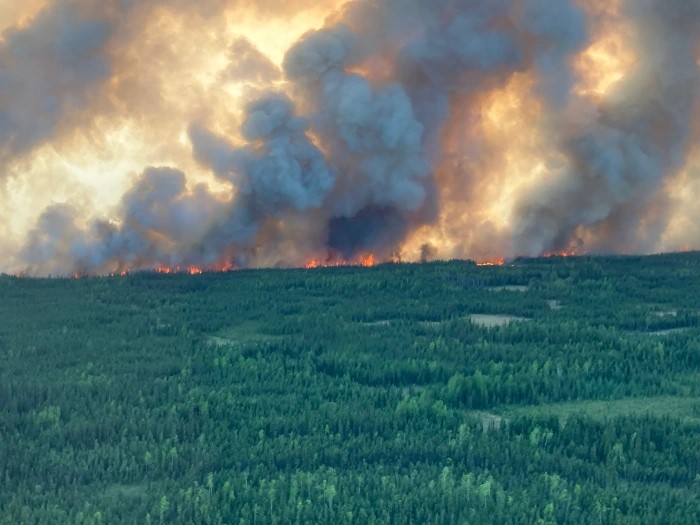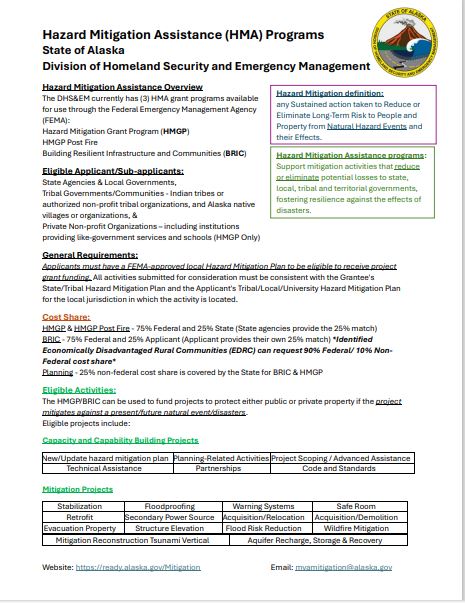What does Hazard Mitigation mean?
Mitigation refers to any sustained action to reduce or eliminate long-term risk to people and property from natural hazards and their affects.
The Division of Homeland Security and Emergency Management (DHS&EM) currently has 2 Hazard Mitigation Assistance (HMA) grant programs available for use through the Federal Emergency Management Agency (FEMA):
- Hazard Mitigation Grant Program (HMGP)
- HMGP Post Fire
These HMA programs are designed to assist eligible applicants reduce or eliminate the risk of loss of life and property due to mitigating future natural hazard disasters through the HMGP.
There is a cost share requirement:
- HMGP & HMGP Post Fire - 75% Federal and 25% Non-Federal (State agencies provide the 25% match)
Who are eligible applicants or sub-applicants?
- State Agencies
- Local Governments
- Tribal Governments / Communities - Indian tribes or authorized non-profit tribal orgnaizations and Alaska native villages or organizations
- Private Non-profit Organizations (HMGP only) - Certain private non-private organizations or institutions (e.g. schools)
Individuals or businesses may not apply directly to the State or FEMA, however, eligible local governments or private non-profit organizations may apply on their behalf.
HMGP funding is announced by DHS&EM following a federally declared disaster in Alaska and will be posted on the DHS&EM website with the amount of funding available depending on the disaster size.
BRIC was cancelled by FEMA on April 4, 2025.
What type of projects are eligible?
Voluntary acquisition of real property (i.e. structures and land, where necessary) for open space conversion;
- Relocation of public or private structures
- Elevation of existing public or private structures to avoid flooding
- Structural and non-structural retrofitting (e.g., storm shutters, hurricane clips, bracing systems) of existing public or private structures to meet/exceed applicable building codes
- Construction of safe rooms (tornado and severe wind shelters) for public and private structures that meet requirements in FEMA 320 and FEMA 361
- Hydrologic and Hydraulic studies/analyses, engineering studies and drainage studies for the purpose of project design and feasibility determination directly related to the proposed project
- Vegetation management for natural dune restoration, wildfire, or snow avalanche
- Protective measures for utilities (e.g. electricity, gas); water and sanitary sewer systems and/or infrastructure (e.g. roads and bridges)
- Storm water management projects (e.g., culverts, retention basins) to reduce or eliminate long-term risk from flood hazards; and
- Localized flood control projects (certain ring levees, bank stabilization, floodwall systems) that are designed specifically to protect critical facilities and that do not constitute a section of a larger flood control system
- New city, tribe, or borough mitigation plan development
- Updating of an existing FEMA Approved mitigation plan
Are there any General Requirements?
Applicants must have a FEMA-approved local mitigation plan in accordance with 44 C.F.R. Parts 201.6 and 206.434(b) to be eligible to receive project grant funding.
What does the Application Process look like?
The primary responsibility for selecting and administering mitigation activities resides with the State. The State sets mitigation priorities and selects project applications that are developed and submitted by local jurisdictions.
The State will send out a Notice of Funding Opportunity (NOFO) and a Notice of Interest (NOI) to the State HMA webpage and as many Cities, Boroughs, and Tribes as possible. Once the NOI is recieved back by the State, the State will determine Sub-Appliant eligibility and eligibility of project, then send the appropriate project application and additional required documents as well as an instruction on how to fill out the application.
Although individuals may not apply directly to the State for assistance, local governments may sponsor an application on their behalf. After its eligibility review, the State forwards applications consistent with State mitigation planning objectives to FEMA for review and approval.



2018 Alaska Earthquake: Vine Rd, Wasilla 2022 Lowel Pt. Landslide, Seward 2024 McDonald Wildfire, Fairbanks
Hazard Mitigation Grant Program
Notice of Funding Opportunity for DR-4767 & DR-4836 & DR-4846 & DR-4859
Building Resilient Infrastructure and Communities (BRIC)
BRIC was Cancelled by FEMA on April 4, 2025
Local Hazard Mitigation Planning
DHS&EM Hazard Mitigation Assistance (HMA) Programs Handout

|
Are you wondering if there is upcoming
training or conferences?
|
Check out the Mitigation Updates page! |

